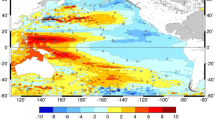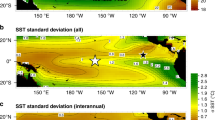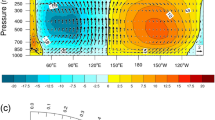Abstract
Combining data from Argo and the TAO buoy array we present new observations of variability in the Pacific Ocean. Argo profiles reveal the development of a thickness anomaly in the lower levels of the ventilated thermocline of the South Pacific in 2010. Data through 2017 show this anomaly propagating as a baroclinic wave westward and towards the equator. Theory suggests that this wave will reduce the velocity of the equatorial undercurrent (EUC) when it reaches the equator, transitioning the equatorial Pacific to a warm state. This is supported by TAO array observations that show a past decadal shift in EUC strength around 2000, as well as radiocarbon coral measurements which suggest a similar change in the 1970s, both of which align with phase changes in Pacific decadal variability. Using model simulations with enhanced vertical resolution in the thermocline, we affirm this link between the subtropical south Pacific thermocline and the EUC, which also manifests in eastern Pacific sea surface temperatures. We combine these results to hypothesize a mechanism that may explain some of the decadal variability observed in the Pacific. This mechanism relies on the propagation of anomalies in the structure of the ventilated thermocline from the southeastern Pacific to the equatorial Pacific, modulating the strength of the EUC. The cycle is enhanced by atmospheric teleconnections between the equatorial Pacific and the southeast Pacific that periodically reverse the anomaly in thermocline thickness. If correct, our hypothesis predicts a return to a warm state of the equatorial Pacific when the Kelvin wave reaches the equator and the thermocline adjustment slows the EUC.







Similar content being viewed by others
References
Amaya DJ, Xie S-P, Miller AJ, McPhaden MJ (2015) Seasonality of tropical Pacific decadal trends associated with the 21st century global warming hiatus. J Geophys Res Oceans 120:6782–6798. https://doi.org/10.1002/2015JC010906
Barsugli JJ, Battisti DS (1998) The basic effects of atmosphere-ocean thermal coupling on midlatitude variability. J Atmos Sci 55:477–493. https://doi.org/10.1175/1520-0469(1998)055%3c0477:TBEOAO%3e2.0.CO;2
Battisti DS (1988) Dynamics and thermodynamics of a warming event in a coupled tropical atmosphere-ocean model. J Atmos Sci 45:2889–2919. https://doi.org/10.1175/1520-0469(1988)045%3c2889:DATOAW%3e2.0.CO;2
Battisti DS, Hirst AC (1989) Interannual variability in a tropical atmosphere-ocean model: influence of the basic state ocean geometry, and nonlinearity. J Atmos Sci 46:1687–1712. https://doi.org/10.1175/1520-0469(1989)046%3c1687:IVIATA%3e2.0.CO;2
Bellenger H, Guilyardi E, Leloup J, Lengaigne M, Vialard J (2014) ENSO representation in climate models: from CMIP3 to CMIP5. Clim Dyn 42:1999–2018. https://doi.org/10.1007/s00382-013-1783-z
Bratcher AJ, Giese BS (2002) Tropical Pacific decadal variability and global warming. Geophys Res Lett 29:1918. https://doi.org/10.1029/2002GL015191
Broecker WS, Peng T-H, Ostlund G, Stuiver M (1985) The distribution of bomb radiocarbon in the ocean. J Geophys Res 90:6953–6970. https://doi.org/10.1029/JC090iC04p06953
Broecker WS, Sutherland S, Smethie W, Peng T-H, Ostlund G (1995) Oceanic radiocarbon: Separation of the natural and bomb components. Global Biogeochem Cycles 9:263–288. https://doi.org/10.1029/95GB00208
Charney JG, Spiegel SL (1971) Structure of wind-driven equatorial currents in homogeneous oceans. J Phys Oceanogr 1:149–160. https://doi.org/10.1175/1520-0485(1971)001%3C0149:SOWDEC%3E2.0.CO;2
Chelton DB, Schlax MG (1996) Global observations of oceanic Rossby waves. Science 272:234–238. https://doi.org/10.1126/science.272.5259.234
Chelton DB, DeSzoeke RA, Schlax MG (1998) Geographic variability of the first baroclinic rossby radius of deformation. J Phys Oceanogr 28:433–460. https://doi.org/10.1175/1520-0485(1998)028%3c0433:GVOTFB%3e2.0.CO;2
Chelton DB, Schlax MG, Samelson RM, de Szoeke RA (2007) Global observations of large oceanic eddies. Geophys Res Lett 34:15606. https://doi.org/10.1029/2007GL030812
Dee DP et al (2011) The ERA-Interim renanalysis: configuration and performance of data assimilation system. Q J Roy Meteor Soc 137:553–597. https://doi.org/10.1002/qj.828
Druffel ERM (1987) Bomb radiocarbon in the Pacific: annual and seasonal timescale variations. J Mar Res 45:667–698. https://doi.org/10.1357/002224087788326876
Fine RA, Peterson WH, Ostlund HG (1987) The penetration of tritium into the tropical pacific. J Phys Oceanogr 17:553–564. https://doi.org/10.1175/1520-0485(1987)017<0553:TPOTIT>2.0.CO;2
Galanti E, Tziperman E (2003) A midlatitude-ENSO teleconnection mechanism via baroclinically unstable long rossby waves. J Phys Oceanogr 33:1877–1888. https://doi.org/10.1175/1520-0485(2003)033%3c1877:AMTMVB%3e2.0.CO;2
Giese BS, Urizar SC, Fučkar NS (2002) Southern Hemisphere origins of the 1976 climate shift. Geophys Res Lett 29:1014. https://doi.org/10.1029/2001GL013268
Godfrey JS (1975) On ocean spindown I: a linear experiment. J Phys Oceanogr 5:399–409. https://doi.org/10.1175/1520-0485(1975)005%3c0399:OOSIAL%3e2.0.CO;2
Gregg MC (1987) Diapycnal mixing in the thermocline: a review. J Geophys Res 92:5249–5286. https://doi.org/10.1029/JC092iC05p05249
Gu D, Philander SGH (1997) Interdecadal climate fluctuations that depend on exchanges between the tropics and extratropics. Science 275:805–807. https://doi.org/10.1126/science.275.5301.805
Guilderson TP, Schrag DP (1998) Abrupt shift in subsurface temperatures in the tropical Pacific associated with changes in El Nino. Science 281:240–243. https://doi.org/10.1126/science.281.5374.240
Hazeleger W, Visbeck M, Cane M, Karspeck A, Naik N (2001) Decadal upper ocean temperature variability in the tropical Pacific. J Geophys Res 106:8971–8988. https://doi.org/10.1029/2000JC000536
Hewitt HT et al (2016) The impact of resolving the Rossby radius at mid-latitudes in the ocean: results from a high-resolution version of the Met Office GC2 coupled model. Geosci Model Dev 9:3655–3670. https://doi.org/10.5194/gmd-9-3655-2016
Huang RX, Pedlosky J (1999) Climate variability inferred from a layered model of the ventilated thermocline. J Phys Oceanogr 29:779–790. https://doi.org/10.1175/1520-0485(1999)029%3c0779:CVIFAL%3e2.0.CO;2
Huang RX, Pedlosky J (2000) Climate variability of the equatorial thermocline inferred from a two-moving-layer model of the ventilated thermocline. J Phys Oceanogr 30:2610–2626. https://doi.org/10.1175/1520-0485(2000)030%3c2610:CVOTET%3e2.0.CO;2
Hurrell JW et al (2013) The community earth system model: a framework for collaborative research. Bull Amer Meteor 94:1339–1360. https://doi.org/10.1175/BAMS-D-12-00121.1
Jin F-F (2001) Low-frequency modes of tropical ocean dynamics. J Clim 14:3874–3881. https://doi.org/10.1175/1520-0442(2001)014%3c3874:LFMOTO%3e2.0.CO;2
Karnauskas KB, Johnson GC, Murtugudde R (2011) An equatorial ocean bottleneck in global climate models. J Clim 25:343–349. https://doi.org/10.1175/JCLI-D-11-00059.1
Kleeman R, McCreary JP, Klinger BA (1999) A mechanism for generating ENSO decadal variability. Geophys Res Lett 26:1743–1746. https://doi.org/10.1029/1999GL900352
Kolodziejczyk N, Gaillard F (2012) Observation of spiciness interannual variability in the Pacific pycnocline. J Geophys Res 117:C12018. https://doi.org/10.1029/2012JC008365
Kuntz LB, Schrag DP (2018) Hemispheric asymmetry in the ventilated thermocline of the tropical Pacific. J Clim 31:1281–1288. https://doi.org/10.1175/JCLI-D-17-0686.1
Kuntz LB, Schrag DP (2020) Representation of the equatorial undercurrent in CMIP5 models. J Phys Oceanogr. https://doi.org/10.1175/JPO-D-20-0007.1
Liu Z (1999) Planetary wave modes in the thermocline: non-Doppler-shift mode, advective mode and Green mode. Q J R Meteorol Soc 125:1315–1339. https://doi.org/10.1002/qj.1999.49712555611
Luo J-J, Masson S, Behera S, Delecluse P, Gualdi S, Navarra A, Yamagata T (2003) South Pacific origin of the decadal ENSO-like variation as simulated by a coupled GCM. Geophys Res Lett 30:2250. https://doi.org/10.1029/2003GL018649
Luyten JR, Pedlosky J, Strommel H (1983) The ventilated thermocline. J Phys Oceanogr 13:292–309. https://doi.org/10.1175/1520-0485(1983)013%3c0292:TVT%3e2.0.CO;2
Lysne J, Chang P, Giese B (1997) Impact of the extratropical Pacific on equatorial variability. Geophys Res Lett 24:2589–2592. https://doi.org/10.1029/97GL02751
Mantua NJ, Hare SR (2002) The Pacific decadal oscillation. J Oceanogr 58:35–44
Marchal O (2009) Extratropical rossby waves in the presence of buoyancy mixing. J Phys Oceanogr 39:2910–2925. https://doi.org/10.1175/2009JPO4139.1
McPhaden MJ, Zhang D (2002) Slowdown of the meridional overturning circulation in the upper Pacific Ocean. Nature 415:603–608. https://doi.org/10.1038/415603a
McPhaden MJ, Zhang D (2004) Pacific Ocean circulation rebounds. Geophys Res Lett 31:L18301. https://doi.org/10.1029/2004GL020727
Newman M, Coauthors, (2016) The Pacific Decadal oscillation, revisited. J Clim 29:4399–4427. https://doi.org/10.1175/JCLI-D-15-0508.1
Newman M, Compo GP, Alexander MA (2003) ENSO-forced variability of the Pacific Decadal Oscillation. J Clim 16:3853–3857. https://doi.org/10.1175/1520-0442(2003)016%3c3853:EVOTPD%3e2.0.CO;2
Ng MKF, Hsieh WW (1994) The equatorial Kelvin wave in finite difference models. J Geophys Res 99:14173–14185. https://doi.org/10.1029/94JC00473
Pedlosky J (1987) An inertial theory of the equatorial undercurrent. J Phys Oceanogr 17:1978–1985. https://doi.org/10.1175/1520-0485(1987)017%3c1978:AITOTE%3e2.0.CO;2
Roberts MJ et al (2009) Impact of resolution on the Tropical Pacific circulation in a matrix of coupled models. J Clim 22:2541–2556. https://doi.org/10.1175/2008JCLI2537.1
Rodgers KB, Cane MA, Naik NH, Schrag DP (1999) The role of the Indonesian Throughflow in equatorial Pacific thermocline ventilation. J Geophys Res 104:20551–20570. https://doi.org/10.1029/1998JC900094
Rodgers KB, Blanke B, Madec G, Aumont O, Ciais P, Dutay J-C (2003) Extratropical sources of Equatorial Pacific upwelling in an OGCM. Geophys. Res. Lett. 30:1084. https://doi.org/10.1029/2002GL016003
Roemmich D, Gilson J (2009) The 2004–2008 mean and annual cycle of temperature, salinity, and steric height in the global ocean from the Argo Program. Prog Oceanogr 82:81–100. https://doi.org/10.1016/j.pocean.2009.03.004
Roemmich, D., and J. Gilson (2018) Roemmich-Gilson Argo climatology. Scripps Institution of Oceanography. Subset used: January 2004–December 2017. http://sio-argo.ucsd.edu/RG_Climatology.html. (Accessed 25 Apr 2018)
Schneider N, Venzke S, Miller AJ, Pierce DW, Barnett TP, Deser C, Latif M (1999b) Pacific thermocline bridge revisited. Geophys Res Lett 26:1329–1332. https://doi.org/10.1029/1999GL900222
Schneider N, Miller AJ, Alexander MA, Deser C (1999a) Subduction of decadal North Pacific temperature anomalies: observations and dynamics. J Phys Oceanogr 29:1056–1070. https://doi.org/10.1175/1520-0485(1999)029,1056:SODNPT.2.0.CO;2
Stewart KD, McC A, Hogg SM, Griffies AP, Heerdegen ML, Ward PS, England MH (2017) Vertical resolution of baroclinic modes in global ocean models. Ocean Model 113:50–65. https://doi.org/10.1016/j.ocemod.2017.03.012
Suarez MJ, Schopf PS (1988) A delayed action oscillator for ENSO. J Atmos Sci 45:3283–3287. https://doi.org/10.1175/1520-0469(1988)045%3c3283:ADAOFE%3e2.0.CO;2
TAO Project Office (2000) Tropical atmosphere ocean/triangle trans-ocean buoy network. NOAA/PMEL. https://www.pmel.noaa.gov/tao/drupal/disdel/. (Accessed 21 Jul 2016)
Trenberth KE, Hurrell JW (1994) Decadal atmosphere-ocean variations in the Pacific. Clim Dyn 9:303–319
Trenberth KE, Fasullo JT, Branstator G, Phillips AS (2014) Seasonal aspects of the recent pause in surface warming. Nat Clim Change 4:911–916. https://doi.org/10.1038/nclimate2341
von Schuckmann K, Coauthors (2016) The Copernicus Marine Environment Monitoring Service ocean state report. J Oper Oceanogr 9:s235–s320. https://doi.org/10.1080/1755876X.2016.1273446
Yang C, Giese BS, Wu L (2014) Ocean dynamics and tropical Pacific climate change in ocean reanalyses and coupled climate models. J Geophys Res Oceans 119:7066–7077. https://doi.org/10.1002/2014JC009979
Zhang D, McPhaden MJ (2006) Decadal variability of the shallow Pacific meridional overturning circulation: relation to tropical sea surface temperatures in observations and climate change models. Ocean Model 15:250–273. https://doi.org/10.1016/j.ocemod.2005.12.005
Zhang X, McPhaden MJ (2010) Surface layer heat balance in the eastern equatorial Pacific ocean on interannual time scales: influence of local versus remote wind forcing. J Clim 23:4375–4394. https://doi.org/10.1175/2010JCLI3469.1
Acknowledgments
We thank Greg Johnson for assisting with access to TAO data. We thank Mark Cane for advice and inspiration. This material is based upon work supported by a National Science Foundation Graduate Research Fellowship (Grant Number DGE1144152) to LBK and a Star Family Challenge Grant to DPS. Data from the Tropical Atmosphere Ocean Project came from the TAO Project Office of NOAA/PMEL. This study was conducted using E.U. Copernicus Marine Services Information.
Author information
Authors and Affiliations
Corresponding author
Additional information
Publisher's Note
Springer Nature remains neutral with regard to jurisdictional claims in published maps and institutional affiliations.
Supplementary Information
Below is the link to the electronic supplementary material.
Rights and permissions
About this article
Cite this article
Kuntz, L.B., Schrag, D.P. Subtropical modulation of the equatorial undercurrent: a mechanism of Pacific variability. Clim Dyn 56, 1937–1949 (2021). https://doi.org/10.1007/s00382-020-05568-w
Received:
Accepted:
Published:
Issue Date:
DOI: https://doi.org/10.1007/s00382-020-05568-w




